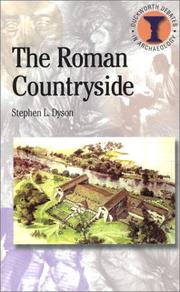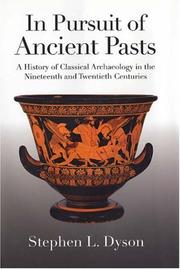| Listing 1 - 10 of 28 | << page >> |
Sort by
|

ISBN: 9780715632253 Year: 2010 Publisher: London : Duckworth,
Abstract | Keywords | Export | Availability | Bookmark
 Loading...
Loading...Choose an application
- Reference Manager
- EndNote
- RefWorks (Direct export to RefWorks)
Land use, Rural --- Architecture, Domestic --- Land settlement --- Utilisation agricole du sol --- Architecture domestique --- Colonisation intérieure --- History --- Histoire --- Rome --- Antiquities --- Antiquités --- History. --- Antiquities. --- Colonisation intérieure --- Antiquités
Book
ISBN: 0860542394 9780860542391 Year: 1983 Volume: 187 Publisher: Oxford : BAR,
Abstract | Keywords | Export | Availability | Bookmark
 Loading...
Loading...Choose an application
- Reference Manager
- EndNote
- RefWorks (Direct export to RefWorks)
Architecture, Domestic --- Architecture domestique --- Rome --- Buccino (Italy) --- Buccino (Italie) --- Antiquities. --- Antiquities --- Antiquités --- Antiquités
Book
ISBN: 0860543021 Year: 1985 Publisher: Oxford : BAR,
Abstract | Keywords | Export | Availability | Bookmark
 Loading...
Loading...Choose an application
- Reference Manager
- EndNote
- RefWorks (Direct export to RefWorks)
Archaeology and history --- Europeans --- -Ethnology --- Historical archaeology --- History and archaeology --- History --- Antiquities --- Americas --- Australia --- New World --- Western Hemisphere --- Discovery and exploration. --- Antiquities. --- Archaeology and history. --- -Antiquities --- Ethnology --- America
Book
ISBN: 0691035776 Year: 1985 Publisher: Princeton (N.J.) : Princeton university press,
Abstract | Keywords | Export | Availability | Bookmark
 Loading...
Loading...Choose an application
- Reference Manager
- EndNote
- RefWorks (Direct export to RefWorks)
Rome --- Boundaries --- -History. --- Colonies --- Provinces --- Roman provinces --- Administration --- History. --- Provinces of Rome --- Administration&delete& --- History --- Rim --- Roman Empire --- Roman Republic (510-30 B.C.) --- Romi (Empire) --- Byzantine Empire --- Rome (Italy)
Book
ISBN: 0801841755 Year: 1992 Publisher: Baltimore Johns Hopkins university press
Abstract | Keywords | Export | Availability | Bookmark
 Loading...
Loading...Choose an application
- Reference Manager
- EndNote
- RefWorks (Direct export to RefWorks)
Cities and towns, Ancient --- -Italy --- -Geography, Ancient --- Rural conditions --- Italy --- Antiquities, Roman. --- History --- -Cities and towns, Ancient --- Rural conditions. --- -Rural conditions --- Geography, Ancient
Book
ISBN: 9780521874595 9781139029759 Year: 2019 Publisher: Cambridge Cambridge University Press
Abstract | Keywords | Export | Availability | Bookmark
 Loading...
Loading...Choose an application
- Reference Manager
- EndNote
- RefWorks (Direct export to RefWorks)
"This study has grown out of several long standing scholarly interests and personal enthusiasms. First and foremost is my devotion to Rome, not just the ancient city of the classicists and archaeologists, but medieval, early modern, and modern Rome. Much of that fascination comes from the fact that Rome is not a museum, but a living, dynamic city, shaped, informed, and constrained by its past, but never subservient to it"--
Archaeology --- Archaeology and state --- Archaeology and religion --- Salvage archaeology --- Social aspects --- History. --- Rome (Italy) --- Antiquities.

ISBN: 1281734586 9786611734589 0300134975 9780300134971 9781281734587 0300110979 9780300110975 Year: 2006 Publisher: New Haven ; London Yale University Press
Abstract | Keywords | Export | Availability | Bookmark
 Loading...
Loading...Choose an application
- Reference Manager
- EndNote
- RefWorks (Direct export to RefWorks)
The stories behind the acquisition of ancient antiquities are often as important as those that tell of their creation. This fascinating book provides a comprehensive account of the history and development of classical archaeology, explaining how and why artifacts have moved from foreign soil to collections around the world. As archaeologist Stephen Dyson shows, Greek and Roman archaeological study was closely intertwined with ideas about class and social structure; the rise of nationalism and later political ideologies such as fascism; and the physical and cultural development of most of the important art museums in Europe and the United States, whose prestige depended on their creation of collections of classical art. Accompanied by a discussion of the history of each of the major national traditions and their significant figures, this lively book shows how classical archaeology has influenced attitudes about areas as wide-ranging as tourism, nationalism, the role of the museum, and historicism in nineteenth- and twentieth-century art.
Archaeology --- Archaeology and history --- Classical antiquities. --- Antiquities, Classical --- Antiquities, Grecian --- Antiquities, Roman --- Archaeology, Classical --- Classical archaeology --- Roman antiquities --- Antiquities --- Archaeological museums and collections --- Art, Ancient --- Classical philology --- Historical archaeology --- History and archaeology --- History --- Archeology --- Anthropology --- Auxiliary sciences of history --- Mediterranean Region --- Antiquities. --- Classical antiquities --- Archéologie --- Histoire --- Méditerranée, Région de la --- Antiquités --- Ancient history --- anno 1800-1899 --- anno 1900-1999 --- Mediterranean countries --- Archaeology -- History -- 19th century.. --- Archaeology -- History -- 20th century.. --- Archaeology and history -- Mediterranean Region.. --- Classical antiquities.. --- Mediterranean Region -- Antiquities.
Book
ISBN: 1438452624 9781438452623 9781438452616 1438452616 Year: 2014 Publisher: Albany, N.Y.
Abstract | Keywords | Export | Availability | Bookmark
 Loading...
Loading...Choose an application
- Reference Manager
- EndNote
- RefWorks (Direct export to RefWorks)
Finalist for the 2014 ForeWord IndieFab Book of the Year Award in the Biography CategoryThis fascinating biography tells the story of William J. Stillman (1828–1901), a nineteenth-century polymath. Born and raised in Schenectady, New York, Stillman attended Union College and began his career as a Hudson River School painter after an apprenticeship with Frederic Edwin Church. In the 1850s, he was editor of The Crayon, the most important journal of art criticism in antebellum America. Later, after a stint as an explorer-promoter of the Adirondacks, he became the American consul in Rome during the Civil War. When his diplomatic career brought him to Crete, he developed an interest in archaeology and later produced photographs of the Acropolis, for which he is best known today. In yet another career switch, Stillman became a journalist, serving as a correspondent for The Times of London in Rome and the Balkans. In 1871, he married his second wife, Marie Spartali, a Pre-Raphaelite painter, and continued to write about history and art until his death. One of the later products of the American Enlightenment, he lived a life that intersected with many strands of American and European culture. Stillman can indeed be called "the last amateur."
Journalists --- Photographers --- Art critics --- Stillman, William James, --- Stillman, W. J. --- Travel. --- United States --- Intellectual life
Book
ISBN: 1139029754 1108631142 0521874599 1108577148 Year: 2019 Publisher: Cambridge : Cambridge University Press,
Abstract | Keywords | Export | Availability | Bookmark
 Loading...
Loading...Choose an application
- Reference Manager
- EndNote
- RefWorks (Direct export to RefWorks)
Rome is one of the world's greatest archaeological sites, preserving many major monuments of the classical past. It is also a city with an important post-Roman history and home to both the papacy and the modern Italian state. Archaeologists have studied the ruins, and popes and politicians have used them for propaganda programs. Developers and preservationists have fought over what should and should not be preserved. This book tells the story of those complex, interacting developments over the past three centuries, from the days of the Grand Tour through the arrival of the fascists, which saw more destruction but also an unprecedented use of the remains for political propaganda. In post-war Rome, urban development predominated over archaeological preservation and much was lost. However, starting in the 1970s, preservationists have fought back, saving much and making the city into Europe's most important case study in historical preservation and historical loss.
Archaeology --- Archeology --- Anthropology --- Auxiliary sciences of history --- History --- Antiquities --- Social aspects --- Rome (Italy) --- Antiquities.
Book
Year: 1976 Publisher: Rome: American academy in Rome,
Abstract | Keywords | Export | Availability | Bookmark
 Loading...
Loading...Choose an application
- Reference Manager
- EndNote
- RefWorks (Direct export to RefWorks)
| Listing 1 - 10 of 28 | << page >> |
Sort by
|

 Search
Search Feedback
Feedback About UniCat
About UniCat  Help
Help News
News